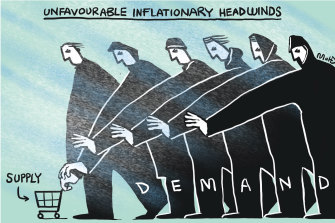So, the economy is rolling on normally until governments suddenly order us to lock down. Obviously, this will involve many people losing their jobs and many businesses losing sales. It will be a government-ordered recession.
Since it’s government-ordered, however, governments know they have an obligation to provide workers and businesses with income to offset their losses. Fearing a prolonged recession, governments spend huge sums and the Reserve Bank cut the official interest rate to almost zero.

illustrationCredit:Matt Davidson
Get it? This was a government-ordered restriction of the supply of goods and services, but governments responded as though it was just a standard recession where demand had fallen below the economy’s capacity to produce goods and services and needed an almighty boost to get it back up and running.
The rate of unemployment shot up to 7.5 per cent, but the national lockdown was lifted after only a month or two. As soon it was, everyone – most of whom had lost little in the way of income – started spending like mad, trying to catch up.
Unemployment started falling rapidly and – particularly because the pandemic had closed our borders to all “imported labour” for two years – ended up falling to its lowest rate since 1974.
loading
So, everything in the garden’s now lovely until, suddenly, we find inflation shooting up to 6.1 per cent and headed higher.
What do we do? What we always do: start jacking up interest rates to discourage borrowing and spending. When demand for goods and services runs faster than business’s capacity to supply them, this puts upward pressure on prices. But when demand weakens, this puts downward pressure on prices.
One small problem. The basic cause of our higher prices isn’t excess demand, it’s a fall in supply. The main cause is disruption to the supply of many goods, caused by the pandemic. To this is added the reduced supply of oil and gas and foodstuffs caused by Russia’s attack on Ukraine. At home, meat and vegetable prices are way up because of the end of the drought and then all the flooding.
Get it? Once again, we’ve taken a problem on the supply side of the economy and tried to fix it as though it’s a problem with demand.
Because the pandemic-caused disruptions to supply are temporary, the Ukraine war will end eventually, and production of meat and veg will recover until climate change’s next blow, we’re talking essentially about prices that won’t keep rising quarter after quarter and eventually should fall back. So surely, we should all just be patient and wait for prices to return to normal.
But it’s our misdiagnosis of the “coronacession” that’s left us with demand so strong it’s too easy for businesses to get away with slipping in price increases that have nothing to do with supply shortages.
Why then are the financial markets and the econocrats so worried that prices will keep rising, we’ll be caught up in a “wage-price spiral” and the inflation rate will stay far too high?
Short answer: because of our original error in deciding that a temporary government-ordered partial cessation of supply should be treated like the usual recession, where demand is flat on its back and needs massive stimulus if the recession isn’t to drag on for years .
If we’d only known, disruptions to supply were an inevitable occurrence as the pandemic eased. What no one foresaw was everyone cooped up in their homes, still receiving plenty of income, but unable to spend it on anything that involved leaving home.
loading
It was the advent of the internet that allowed so many of us to keep working or studying from home. And it was the internet that allowed us to keep spending, but on goods rather than services. It’s the huge temporary switch from buying services to buying goods that’s done so much to cause shortages in the supply of many goods.
But it’s our misdiagnosis of the “coronacession” – propping up workers and industries far more than they needed to be – that’s left us with demand so strong it’s too easy for businesses to get away with slipping in price increases that have nothing to do with supply shortages.
Now all we need to complete our error is to overreact to the price rises and tighten up so hard we really do have an old-style recession.

